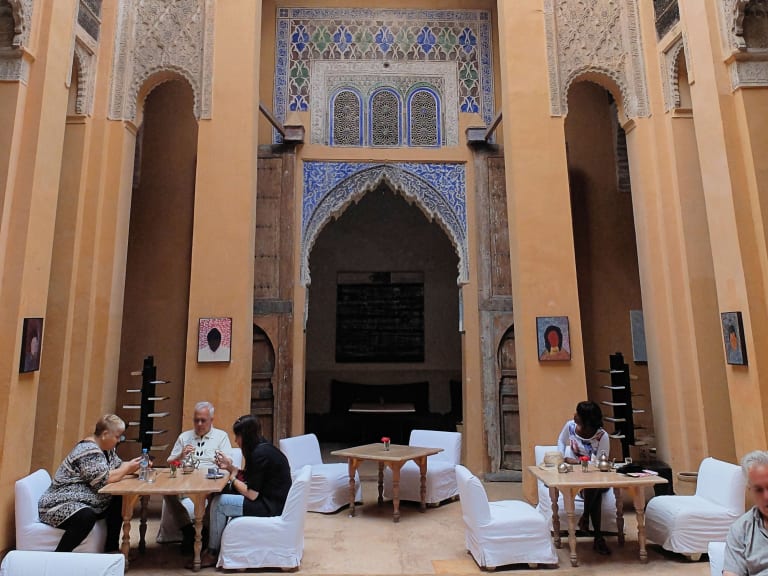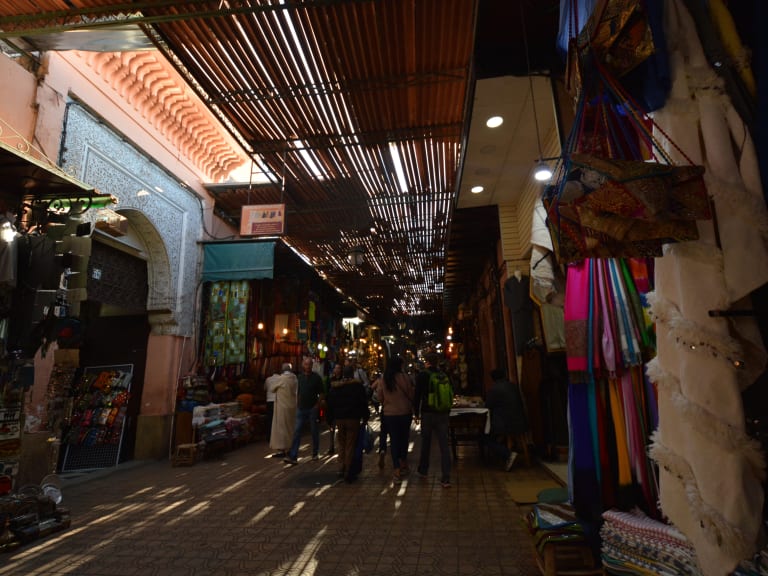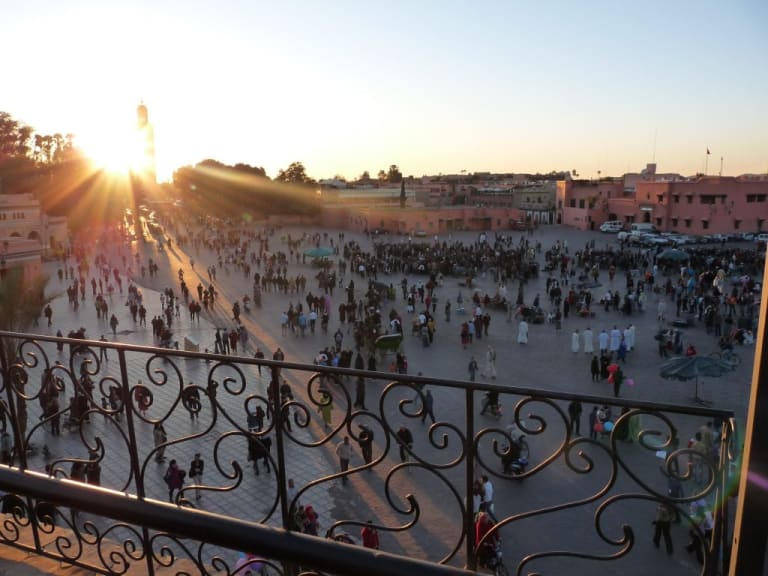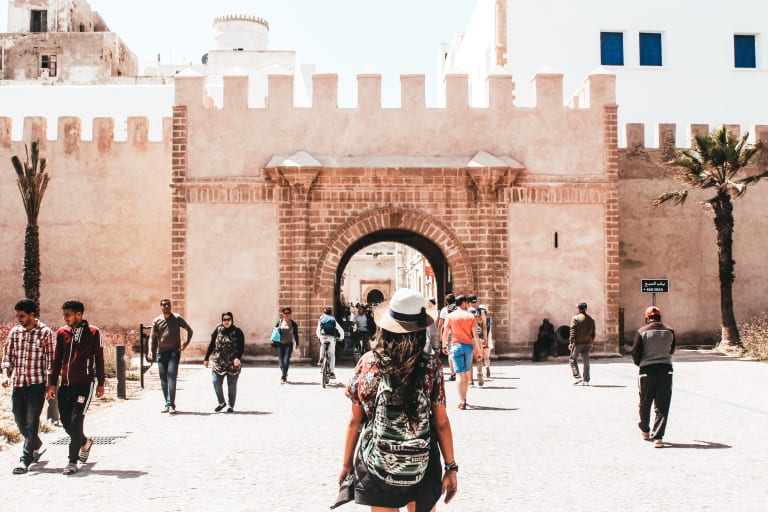More about: Marrakech in a day: quick guide to the city
You only have one day to visit Marrakech and you want to make the most of your time? The good news is that, at least, you'll be able to visit the city's must-see sights. The bad news is that you won't be able to get to know the city in depth in that time and, above all, it will be difficult to capture all the magic it transmits.
To make the most of those 24 hours, we have prepared this itinerary that covers the most interesting visits, although at a faster pace than you would like. In any case, I can assure you that you will enjoy the experience as long as you are open-minded and adventurous.
Start your day by crossing Bab Agnaou

Your day in Marrakech should start early to make the most of your time. When planning your route, take into account the time of sunset, as it varies greatly depending on whether you visit Marrakesh in winter or summer, as temperatures have been very high in recent summer seasons.
To begin with, head south until you find two gates to the city that are almost next to each other: Bab Agnaou and Bab Er Robb (Bab means "gate" in Arabic). The former consists of only four arches through which pedestrians and cars enter and exit, and is of relative interest. Bab Agnaou, however, is worth a visit.
This 12th-century single-coloured gateway connects through a central arch to the royal kashbah, where the El Badi palace and the Sa'did tombs are located. Bab Agnaou was one of the 19 entrances in the wall surrounding the medina.
Guided or self-guided tour?
This one-day tour of Marrakesh can be done on your own or you can also take one of the many guided tours offered by the city. Both options have their pros and cons, so you will have to decide which one you prefer. The main advantage of having a guide to take you around the city is that you will avoid the presence of fake guides and you will receive interesting information about what you are seeing.
On the other hand, you won't experience the magic of getting lost (literally) in the narrow streets, although with so little time you may miss some places. A good tip is not to despair until you learn your way around Marrakesh.
Saadid Tombs

Guided by a green-tiled minaret, a few metres from Bab Agnaou you reach the Mulay El Yazid Mosque, of which the minaret is part of. Entry to the temple is forbidden to non-Muslims (something you should know when preparing your visit to Marrakesh) but next to it are the Saadid tombs.
These tombs date from the late 16th century. It was then that the ruling sultan, Al Mansur, ordered their construction, but a few decades later another sultan, Mulay Ismail, blocked access to them. For some reason, the tombs fell into oblivion until 1917, when they were rediscovered. Today the tombs are open to visitors, although there is a fee to enter. To enter you have to walk through a narrow passageway leading to a small garden. Here you will find the tombs of several warriors, chancellors and servants.
In addition, you can also see some of the buildings in which more important figures are buried. The Hall of the 12 Columns, where the remains of Sultan Al Mansur himself lie, stands out for its beauty.
Bahia Palace

To reach the next destination you have to wander through the southern part of the Medina of Marrakech, for which you can also book a tour to get to know it better. And, although the goal is to reach the Bahia Palace, on the way it is worth making a short stop at the Place des Ferblantiers, as it retains a great charm and is full of shops specialising in metal products, especially tinplate.
Leaving this square behind you finally reach the Palais de la Baie. Its construction dates back to the end of the 19th century, when they tried to build the largest palace of all time.
The most interesting part of its interior is the harem, which has a pond in a central courtyard that was surrounded by the rooms of the concubines. We advise you to spend a little bit of your time wandering around the wonderful gardens, and be aware that if you don't go with your own guide, there will be quite a few guides (fake or not) in this area who will try to get you to hire them, they can even be a bit annoying, so my advice is to avoid them.
Dar Si Said Museum

The city of Marrakech is not usually associated with museums, but rather with its streets or excursions to deserts such as Zagora, even booking a sweet evening with dinner if you wish. However, the Dar Si Said museum may be worth a short visit.
To get there you will have to walk through some narrow alleys trying not to get lost. Besides the fact that its collection is the most complete in the city, it is worth contemplating its courtyards and the decoration of its ceilings, doors and furniture made of cedar wood.
Jamaa el Fna Square

If there is one image that represents Marrakech, it is Jamaa el Fna Square. This is where you should go when you leave the museum, as it is an essential visit when you are in Morocco. This will be the first time you visit the square, as you will return at sunset to see the great change that takes place. On this first visit, the square will be full of vendors selling fresh juices, dried fruits and nuts, water carriers and traders selling all kinds of products.
You will also find many typical street performers such as snake charmers and monkey tamers. Of course, you will also find the typical henna tattoo stalls, a must on your visit!
It is quite likely that you will want to photograph almost everything in the square, but we recommend that you never do so without first asking permission and negotiating a price.
Lunch and relaxation at Dar Cherifa

Now it's time to recover your strength and sample some of Morocco's delicious food. The best way to get to know this cuisine is to book a dedicated tour, but you may find this a bit of a challenge if you're only in Marrakesh for a day.
The best possible place to relax and have a bite to eat is Dar Cherifa, one of the oldest riads in the city. The most popular dishes (deservedly so) served at Dar Cherifa are tajines and couscous. Whichever you choose, you're sure to get it right.
The Souk

The word souk comes from the Arabic "suq", which means market. So it is clear that the next few hours of the tour will be spent wandering through the narrow streets dedicated to the sale of all kinds of products.
The streets that make up the souk are usually completely packed with people and visitors and passers-by compete to find a space to see the stalls and be able to walk around at their leisure. My advice for travelling to Marrakech is to take it easy and avoid vendors who try to get you to buy in a more aggressive manner.
The traditional thing to do when wandering around the souk is to wander aimlessly and look at all the merchandise on display: slippers, djellabas, spices, metal lanterns, tea sets, etc. If you like something, remember that it is customary to buy it in the souk. If you like something, remember that it is customary to haggle with the seller until you reach an agreement, or not.
On your walk you will realise that there are actually several souks that coexist on this street, divided according to what they sell. In one area you can find coloured sun-dried wool, while in others you'll find cosmetics, carpets and silk garments, respectively.
A very interesting area is Rahba Kedima Square, just outside the souk. Here you will find spices of all kinds, medicinal herbs and basketry.
Medersa Ben Youssef

After the adventure of touring the souk, it's time to visit the Medersa Ben Youssef. This was the largest Muslim school in the whole country in the 16th century and later.
Its interior courtyard is remarkable, decorated with an iron chandelier, arches and tiled walls and marble and wood panelling.
Nearby is the Marrakesh Museum. Unless you're really interested in going inside, I advise you to just peek into the inner courtyard, as it's well worth a visit.
Next to the museum you can see the Almoravid Qoubba (a dynasty that also ruled Essaouira and other Moroccan territories), the only example of this artistic style that remains in the city.
There I recommend you take a look at the Souk Foudouq Quarzazi, a souk located inside a foundouk, a word that designated the lodgings dedicated to the members of the ancient caravans that travelled through the desert to reach the city.
Koutoubia Mosque

Walking back to the centre you reach the Koutoubia Mosque, the most important mosque in Marrakesh. Although you can't visit the inside, its 66-metre-high minaret (some sources say it is 77 metres high) is truly impressive.
This mosque was built in 1158 and was once one of the largest in the Muslim world. The aforementioned minaret closely resembles the Giralda in Seville and remains the highest point in the city.
Enjoy the sunset on the terrace of the Café Glacier

As I'm sure you must be quite tired by now and the timetable suggests it, now is the time to head to Café Glacier for a delicious mint tea on the terrace.
From the terrace you can watch the sunset and the neighbouring Jamaa el Fna square transform as the sun goes down.
Return to the Jamaa el Fna square.
As night falls, the vendors who used to occupy the square disappear from the square. They are replaced by a multitude of food stalls competing to attract visitors.
This is the perfect place to have a drink before returning to the hotel. Before choosing where to sit, it's best to take a stroll around to see what each of the stalls has to offer.
Joaquín's Traveller Tip
competition between the different food stalls is fierce and sometimes a vendor can be a bit of a pain. Always keep your cool and don't hesitate to sit in the place you like best despite the calls of others.
Where to stay in Marrakech

Some of the accommodation you will find in Marrakesh can be counted among the city's tourist attractions. These are the riads, old traditional houses that have been converted into hotels and/or restaurants.
The accommodation in riads tends to have few rooms and to be very quiet. They usually have a central courtyard and a terrace overlooking the rooftops of the city.
Beware of false guides

As mentioned above, and if you've been doing some research on safety in Marrakech, you've probably read about the false guide.
As in other Moroccan cities, it's not uncommon to find unaccredited guides on the streets trying to persuade you to hire them. Unlike the accredited guides, they are not subject to an official fee and can be very insistent.
That's why I advise you to book your guided tour of the city in advance, and not to be persuaded by these fake guides. Promises are usually not kept and it is quite likely that you will end up in the shop of a merchant who takes a commission from you.
Is it worth a day trip to the desert of Marrakech?

There are several organised tours you can take, for example, a trip to the Atlas Mountains and the Agafay Desert from Marrakech or to the Marrakech Palm Grove for camel riding. Both are very worthwhile, but if you're only in the city for a day you should be aware that they will prevent you from enjoying the city.
The decision depends very much on your interests, but it's best to try to extend your stay or, if that's impossible, plan to return in the near future to complete your visit to Marrakesh and enjoy the many excursions you can do from there.




